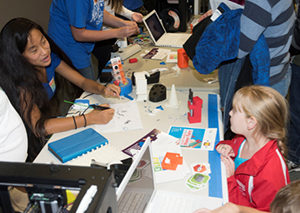The Connectory and FabFems are two free resources that community college educators can use to encourage young people to pursue STEM knowledge and careers.
The Connectory is a national database to publicize STEM youth programs and connect with families and other organizations. FabFebs is a database of female STEM role models and mentors. (See “Scouting and STEM.“)
Both databases are offered by the National Girls Collaborative Project (NGCP), which began with National Science Foundation support. The Connectory was developed and launched by Time Warner Cable for its Connect a Million Minds Initiative. It was merged in 2015 with NGCP’s directory.
NCGP utilizes the research-based SciGirls Seven, another NSF-supported initiative, in its trainings “as a way to guide the experiences girls have in middle school to help broaden their awareness and reception of STEM careers. We do this because SciGirls encourages hands-on activities that support girls’ curiosity and creativity,” says Erin Hogeboom, community development and network strategy manager for The Connectory and NCGP.
Aside from its curriculum guidance, Hogeboom says that SciGirls Seven’s incorporation of diverse women role models helps girls see themselves in STEM careers and aspire to become STEM professionals.
She notes that NCGP has found that mentors make “a tremendous impact in helping to create a bridge for girls from middle school STEM interest to college enrollment.”

Girls learn about design and 3D printing during a National Girls Collaborative Project event organized by the Regional Center for Next Generation Manufacturing, an NSF Advanced Technological Education center.
A mentor who has had the experience of being the only female in a STEM course or club “can help instill a sense of STEM confidence” in girls, Hogeboom says. FabFems is a great resource for girls to find mentors in their area of interest. Women who teach STEM courses at two-year colleges are encouraged to register.
As for the challenge of sustaining youthful enthusiasm for science and math to influence college preparation and then course selection for STEM careers, “Continued participation in quality STEM programming that persistently challenges girls through high school is also a tool for keeping girls engaged in STEM into college,” Hogeboom says.

